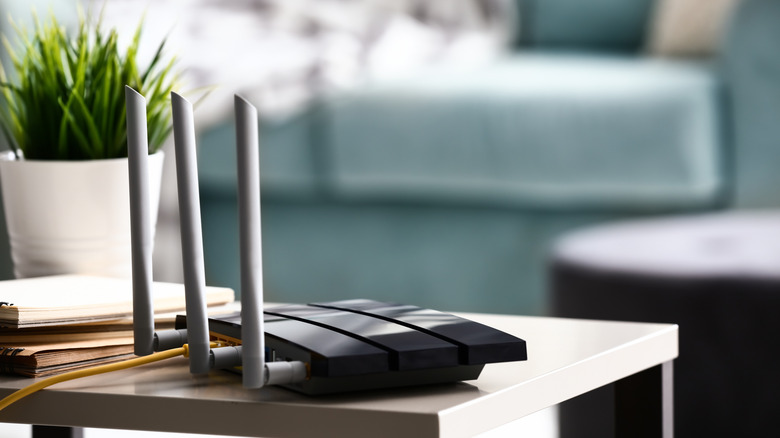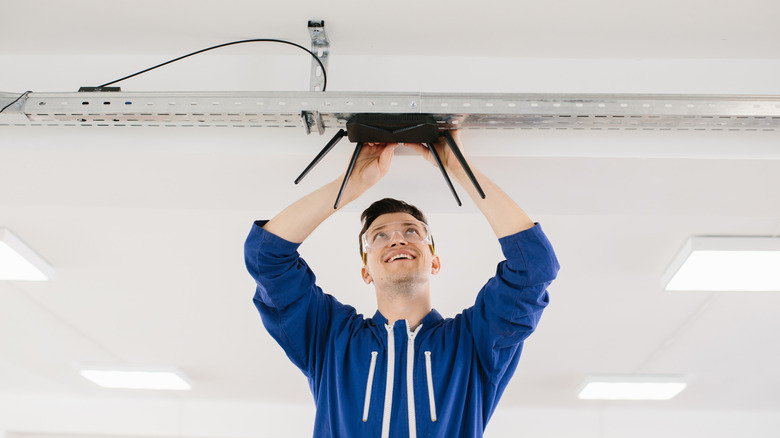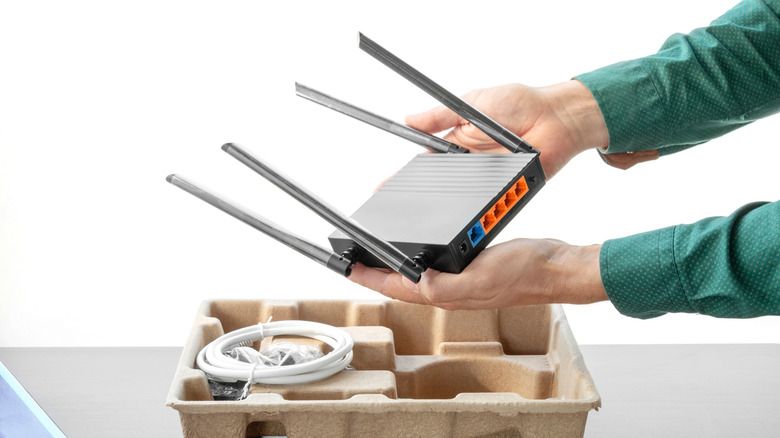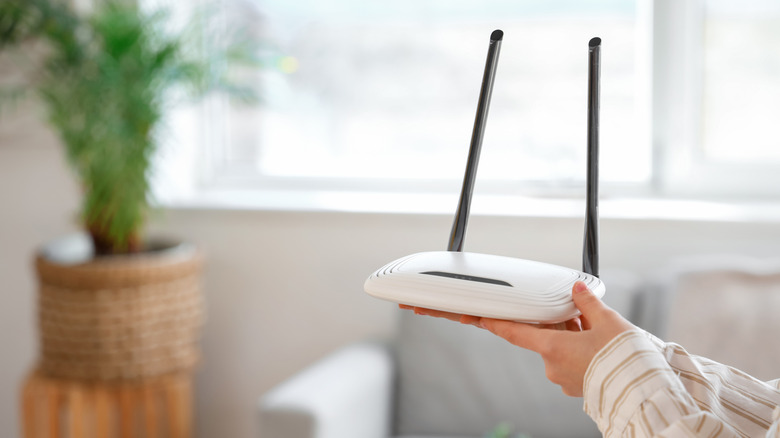8 Ways To Speed Up Your Router (Without Spending Money)
Slow internet is arguably one of the top five worst experiences for any internet user. You may be trying to watch your favorite show on Netflix, only to have it buffering every few minutes. Or your video calls keep freezing at the worst possible moments. Worse yet, you can't even load up a game of Fortnite to play with your friends because your connection keeps timing out.
A lot of things can slow your router down. The placement could be terrible, wedged behind furniture or tucked in a corner where the signal can't reach. Interference from other devices might also be killing your signal, or outdated firmware could be dragging everything down. In many cases, someone might tell you to drop hundreds of dollars on one of the major Wi-Fi mesh systems to improve coverage, or better still, just get a Wi-Fi router with blazing-fast speed.
What they may not tell you is that simple tweaks to your router's settings and placement can make a massive difference in your connection speed. These are things you can do right now, today, using nothing but your time. Here are eight ways to make your router actually perform like it should without spending a penny.
Change router location
Your router's placement matters more than you may think. Walls, furniture, and even fish tanks can block Wi-Fi signals before they reach your devices. To counter this and improve your Wi-Fi speed, you will need to move your router to a central, open spot in your home. Wi-Fi signals spread out in all directions, so sticking your router in a corner means half those signals are just hitting exterior walls. Instead, put it somewhere in the middle of your space where the signal can reach every room.
Height is equally important. When you place your router on a high shelf or mount it on a wall, you get the signal above furniture and other obstacles that can block it. You'll also want to keep your router away from electronics that create interference, such as microwaves, cordless phones, baby monitors, and Bluetooth speakers. If you do this, you should notice immediate improvement in your router performance and overall speed.
Adjust the router's antennas
Those antennas sticking out of your router aren't just for show. They are crucial when it comes to the Wi-Fi signal coverage, but most of us just set them up once (often pointing straight up) and never touch them again. While this might make your router look neat, it can create uneven coverage throughout your home and leave certain areas struggling to get a decent signal.
The thing is, Wi-Fi signals spread perpendicular to the antenna. So, when an antenna points straight up, the WiFi spreads out horizontally across your floor. This is mostly fine if you live in a single-story home, as you will be getting maximum horizontal coverage. However, anyone living in a multi-story house will end up with strong signals in some spots but none in others.
That's why the best approach is to mix the angles of the antennas. You should point one antenna straight up and tilt another one sideways, creating overlapping coverage patterns to reach more areas of your home. It should take you about two minutes to do this, costs absolutely nothing, and you might be surprised how much better those dead zones perform.
Change to a faster frequency band
Most modern routers are dual-band units, which means they support both 2.4GHz and 5GHz frequency bands. The 5GHz band provides faster speeds with less interference because fewer devices use it. The downside, though, is that 5GHz doesn't travel through walls, so its range is shorter. You'll get excellent speeds near the router, but the signal drops off quickly as you move away. The 2.4GHz band works the opposite way. It's slower overall, but the signal reaches farther. This makes it perfect for devices on the other side of your house or on different floors.
To switch between bands, you can go into your router settings and change the default to the frequency that best serves your needs. Some routers let you enable both 2.4GHz and 5GHz frequency bands at the same time, creating two separate Wi-Fi networks. So when you go to connect your devices, you'll see two network names pop up instead of one. The router typically names them something like "YourNetworkName-2.4G" for the 2.4GHz band and "YourNetworkName-5G" for the 5GHz band.
Take advantage of the Quality of Service (QoS) settings
Routers can connect multiple devices at once and although the actual number depends on your router type, most home setups can handle anywhere from 20 to 200 devices. The problem is, the more devices you have connected, the more congested the traffic becomes, and that results in poor performance for everyone. For instance, when someone in your house starts downloading a massive file or streaming 4K video, it can choke out everyone else's connection. Your video conference meeting could start freezing and your game can start lagging. This is where Quality of Service, or QoS, comes in handy, as it lets you control which devices or activities get priority access to your bandwidth.
All you have to do is head to your router's settings, find the QoS section, and rank your devices by importance. For example, your work laptop and gaming console may get top priority, so they always have plenty of bandwidth. Meanwhile, devices doing background downloads or streaming music get lower priority and won't steal bandwidth from critical tasks. Some routers even let you prioritize specific types of traffic instead of just devices. You can tell your router that video calls always get priority over file downloads, as an example.
Update router's firmware
Every device you own has firmware, which is basically the built-in software that tells your hardware how to function. If you're running outdated firmware on any device, it could seriously affect performance. In a router's case, old firmware can directly impact your internet speed. This happens because outdated firmware often includes bugs, glitches, and security issues that mess with how your router performs.
Thankfully, router manufacturers occasionally release firmware updates to fix these problems and improve overall performance. Apart from that, firmware updates can add new features and support for newer devices that older firmware versions couldn't properly handle. However, updating your firmware depends on the router. Newer models may let you update through an app, while others may have a web-based setup.
For the web-based method, you'll need to download the latest firmware from your router manufacturer's website first. Then log into your router's control panel through your web browser using its IP address. Once in, look for a section called "Firmware Update," "Router Update," or something similar. You'll then upload the firmware file you downloaded, hit the update button, and let your router do its thing. The whole process takes a few minutes, and your router reboots itself when everything's done.
Change Wi-Fi channel
Your Wi-Fi router broadcasts on a specific channel, and so does every other router in your neighborhood. The issue with that is when too many routers are using the same channel at the same time, it becomes crowded and slows everyone down. Most routers automatically pick a channel when you first set them up, but that doesn't mean it's the best one.
As a result, your router might be stuck on a crowded channel while quieter options sit empty. An easy way to potentially speed up your Wi-Fi is to switch to a less congested channel. To do this, log into your router's admin page via a web browser, find the wireless settings section, choose your frequency band, and look for the channel selection option. You'll see a dropdown menu or list of available channels.
Now, choose channels 1, 6, or 11 if you're on the 2.4GHz band, as they are non-overlapping channels, meaning they don't interfere with each other. The 5GHz band gives you more channel options that don't overlap since fewer devices use it. But you can manually test different channels to see which performs best. Or better still, use Wi-Fi analyzer apps on your phone to find out which channels are less congested.
Control connections on your Wi-Fi
The QoS setting discussed earlier is one way to control the connections on your WiFi. But you can take that control further by managing who gets access to your network in the first place. Start by setting a strong password if you haven't done so already, butbe sure not to use terrible passwords like "123456," or your street address. Those can be cracked in seconds and leave your network vulnerable to hackers. Hiding your network name (SSID) adds another layer of protection to your Wi-Fi network.
When you disable SSID broadcasting in your router settings, your network won't show up when people search for available Wi-Fi. This means only people who know your exact network name can connect. That aside, you should always check who's connected to your network. You can do that through your router's admin panel or use tools like Wireless Network Watcher. If you find any unauthorized device on your network, you can add it to the block list via your router's admin panel using the device's MAC address.
Contact your ISP
Sometimes the problem with slow internet isn't related your router at all. Your internet service provider might be the reason your speeds are dragging. ISPs occasionally throttle your connection, which means they intentionally slow down speeds during peak hours or when you've used a certain amount of data. A quick call to ask if they're throttling your connection can reveal whether this is happening to you. Sometimes they'll admit it, sometimes they won't, but asking puts the issue on their radar. Besides, you may be paying for a lower-speed plan without even realizing it.
Network issues on your ISP's end can also tank your speeds. There could be a problem with the line coming into your house, an outage in your area, or equipment issues at their facility. In fact, your ISP can run diagnostics remotely to check signal strength and spot problems you can't see. They might even need to send a technician or fix it from their office. Either way, you won't know unless you make the call, which is just one more easy way to potentially speed up your router.








